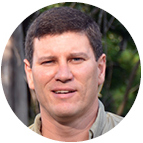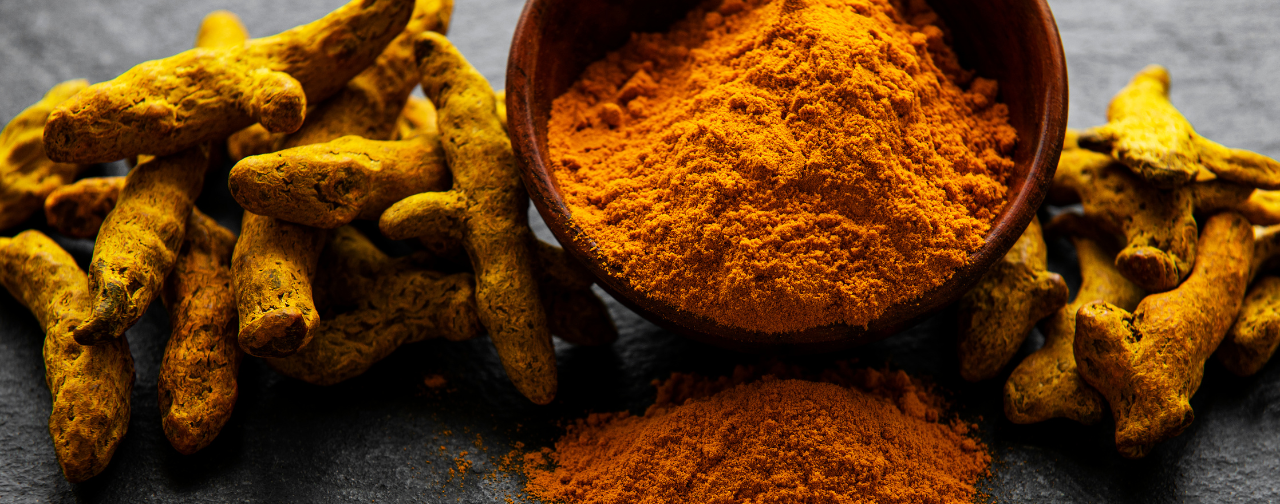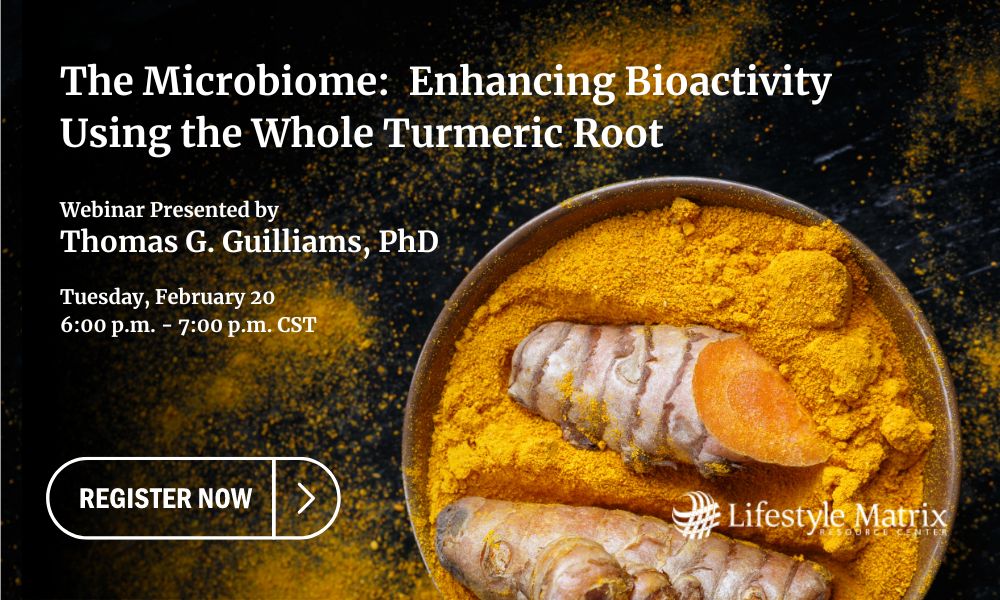*The following is an excerpt taken from a white paper written by Dr. Guilliams: Unlocking the Efficacy of Turmeric Root: Could the Absorption of Curcumin be the Wrong Key? Download the full white paper here.
For historical reasons, the therapeutic potential of turmeric has been disproportionally focused on curcuminoids, which make up only around 5% of the total weight of turmeric root.
However, clinical trials have shown that preparations of whole turmeric or turmeric preparations not designed to concentrate curcuminoids have shown some clinical benefit. These include trials demonstrating biological activities of turmeric when used alone or as an adjuvant therapy in the management and treatment of inflammatory diseases1, rheumatoid arthritis2, osteoarthritis3,4, autoimmune disorders like lupus nephritis5, cancer6-8, diabetes9,10, irritable bowel syndrome11,12, mutagens13 and fibrosis.14
In an in vitro antiproliferation study, whole turmeric preparation had stronger growth-inhibitory effects compared to concentrated curcumin alone (both delivered the same level of curcumin) in various cancer cell lines.15 Another study reported that a turmeric oil-rich extract was more effective than curcumin in inhibiting prostaglandin E2; whereas it had no effect in inhibiting cyclooxygenase-2 (COX-2), like curcumin did.16 These studies highlight the importance of the multi-component therapeutic potency of turmeric; showing that its therapeutic efficacy may be attributed to non-curcuminoid compounds, as well as the synergy between these compounds and curcuminoids.
In fact, while most researchers have been focusing on the promise of increased curcumin bioavailability, many others have been finding therapeutic activities attributed to many of the non-curcuminoid compounds in turmeric, especially related to anti-inflammatory and anti-cancer outcomes.17,18 These include compounds such as turmerin19-22, turmerones23-25, elemene26,27, furanodiene28, curdione29-31, bisacurone32, cyclocurcumin33-35, calebin A36-38, and germacrone.39-41

Thomas G. Guilliams, PhD (Tom) earned his doctorate in molecular immunology from the Medical College of Wisconsin in Milwaukee. For the past two decades, he has spent his time investigating the mechanisms and actions of lifestyle and nutrient-based therapies, and is an expert in the therapeutic uses of dietary supplements. Tom serves as an adjunct assistant professor at the University of Wisconsin School of Pharmacy and was the VP of Science for Ortho Molecular Products for 24 years (he now serves them as a consultant). Since 2014 he has been writing a series of teaching manuals (Road Maps) that outline and evaluate the evidence for the principles and protocols that are fundamental to the functional and integrative medical community. He is the founder and director of the Point Institute, an independent research and publishing organization that facilitates the distribution of his many publications. A frequent guest-speaker, Dr. Guilliams provides training to a variety of health care disciplines in the use of lifestyle and natural medicines. He lives in the woods outside of Stevens Point, Wisconsin with his wife and children.
References
- Behal R, Mali AM, Gilda SS, Paradkar AR. Evaluation of local drug-delivery system containing 2% whole turmeric gel used as an adjunct to scaling and root planing in chronic periodontitis: A clinical and microbiological study. J Indian Soc Periodontol. 2011;15(1):35-38.
- Amalraj A, Varma K, Jacob J, et al. A Novel Highly Bioavailable Curcumin Formulation Improves Symptoms and Diagnostic Indicators in Rheumatoid Arthritis Patients: A Randomized, Double-Blind, Placebo-Controlled, Two-Dose, Three-Arm, and Parallel-Group Study. J Med Food. 2017;20(10):1022-1030.
- Kuptniratsaikul V, Dajpratham P, Taechaarpornkul W, et al. Efficacy and safety of Curcuma domestica extracts compared with ibuprofen in patients with knee osteoarthritis: a multicenter study. Clin Interv Aging. 2014;9:451-458.
- Kuptniratsaikul V, Thanakhumtorn S, Chinswangwatanakul P, Wattanamongkonsil L, Thamlikitkul V. Efficacy and safety of Curcuma domestica extracts in patients with knee osteoarthritis. J Altern Complement Med. 2009;15(8):891-897.
- Khajehdehi P, Zanjaninejad B, Aflaki E, et al. Oral supplementation of turmeric decreases proteinuria, hematuria, and systolic blood pressure in patients suffering from relapsing or refractory lupus nephritis: a randomized and placebo- controlled study. J Ren Nutr. 2012;22(1):50-57.
- Ghalaut VS, Sangwan L, Dahiya K, Ghalaut PS, Dhankhar R, Saharan R. Effect of imatinib therapy with and without turmeric powder on nitric oxide levels in chronic myeloid leukemia. J Oncol Pharm Pract. 2012;18(2):186-190.
- Kuttan R, Sudheeran PC, Josph CD. Turmeric and curcumin as topical agents in cancer therapy. Tumori. 1987;73(1):29-31.
- Prucksunand C, Indrasukhsri B, Leethochawalit M, Hungspreugs K. Phase II clinical trial on effect of the long turmeric (Curcuma longa Linn) on healing of peptic ulcer. Southeast Asian J Trop Med Public Health. 2001;32(1):208-215.
- Khajehdehi P, Pakfetrat M, Javidnia K, et al. Oral supplementation of turmeric attenuates proteinuria, transforming growth factor-beta and interleukin- 8 levels in patients with overt type 2 diabetic nephropathy: a randomized, double-blind and placebo-controlled study. Scand J Urol Nephrol. 2011;45(5):365-370.
- Wickenberg J, Ingemansson SL, Hlebowicz J. Effects of Curcuma longa (turmeric) on postprandial plasma glucose and insulin in healthy subjects. Nutr J. 2010;9:43.
- Bundy R, Walker AF, Middleton RW, Booth J. Turmeric extract may improve irritable bowel syndrome symptomology in otherwise healthy adults: a pilot study. J Altern Complement Med. 2004;10(6):1015-1018.
- Shimouchi A, Nose K, Takaoka M, Hayashi H, Kondo T. Effect of dietary turmeric on breath hydrogen. Dig Dis Sci. 2009;54(8):1725-1729.
- Polasa K, Raghuram TC, Krishna TP, Krishnaswamy K. Effect of turmeric on urinary mutagens in smokers. Mutagenesis. 1992;7(2):107-109.
- Hastak K, Lubri N, Jakhi SD, et al. Effect of turmeric oil and turmeric oleoresin on cytogenetic damage in patients suffering from oral submucous fibrosis. Cancer Lett. 1997;116(2):265-269.
- Kim JH, Gupta SC, Park B, Yadav VR, Aggarwal BB. Turmeric (Curcuma longa) inhibits inflammatory nuclear factor (NF)-kappaB and NF-kappaB-regulated gene products and induces death receptors leading to suppressed proliferation, induced chemosensitization, and suppressed osteoclastogenesis. Mol Nutr Food Res. 2012;56(3):454-465.
- Lantz RC, Chen GJ, Solyom AM, Jolad SD, Timmermann BN. The effect of turmeric extracts on inflammatory mediator production. Phytomedicine. 2005;12(6-7):445-452.
- Aggarwal BB, Yuan W, Li S, Gupta SC. Curcumin-free turmeric exhibits anti-inflammatory and anticancer activities: Identification of novel components of turmeric. Mol Nutr Food Res. 2013;57(9):1529-1542.
- Nair A, Amalraj A, Jacob J, Kunnumakkara AB, Gopi S. Non-Curcuminoids from Turmeric and Their Potential in Cancer Therapy and Anticancer Drug Delivery Formulations. Biomolecules. 2019;9(1).
- Srinivas L, Shalini VK, Shylaja M. Turmerin: a water soluble antioxidant peptide from turmeric [Curcuma longa]. Arch Biochem Biophys. 1992;292(2):617-623.
- Cohly HH, Taylor A, Angel MF, Salahudeen AK. Effect of turmeric, turmerin and curcumin on H2O2-induced renal epithelial (LLC-PK1) cell injury. Free Radic Biol Med. 1998;24(1):49-54.
- Chethankumar M, Srinivas L. New biological activity against phospholipase. A2 by Turmerin, a protein from Curcuma longa L. Biol Chem. 2008;389(3):299-303.
- Lekshmi PC, Arimboor R, Raghu KG, Menon AN. Turmerin, the antioxidant protein from turmeric (Curcuma longa) exhibits antihyperglycaemic effects. Nat Prod Res. 2012;26(17):1654-1658.
- Sandur SK, Pandey MK, Sung B, et al. Curcumin, demethoxycurcumin, bisdemethoxycurcumin, tetrahydrocurcumin and turmerones differentially regulate anti-inflammatory and anti-proliferative responses through a ROS-independent mechanism. Carcinogenesis. 2007;28(8):1765-1773.
- Murakami A, Furukawa I, Miyamoto S, Tanaka T, Ohigashi H. Curcumin combined with turmerones, essential oil components of turmeric, abolishes inflammation-associated mouse colon carcinogenesis. Biofactors. 2013;39(2):221-232.
- Bagad AS, Joseph JA, Bhaskaran N, Agarwal A. Comparative Evaluation of Anti-Inflammatory Activity of Curcuminoids, Turmerones, and Aqueous Extract of Curcuma longa. Adv Pharmacol Sci. 2013;2013:805756.
- Liu J, Zhang Z, Gao J, Xie J, Yang L, Hu S. Downregulation effects of beta- elemene on the levels of plasma endotoxin, serum TNF-alpha, and hepatic CD14 expression in rats with liver fibrosis. Front Med. 2011;5(1):101-105.
- Li G, Xie B, Li X, et al. Down-regulation of survivin and hypoxia-inducible factor- 1 alpha by beta-elemene enhances the radiosensitivity of lung adenocarcinoma xenograft. Cancer Biother Radiopharm. 2012;27(1):56-64.
- Sun XY, Zheng YP, Lin DH, Zhang H, Zhao F, Yuan CS. Potential anti-cancer activities of Furanodiene, a Sesquiterpene from Curcuma wenyujin. Am J Chin Med. 2009;37(3):589-596.
- Oh OJ, Min HY, Lee SK. Inhibition of inducible prostaglandin E2 production and cyclooxygenase-2 expression by curdione from Curcuma zedoaria. Arch Pharm Res. 2007;30(10):1236-1239.
- Hou XL, Hayashi-Nakamura E, Takatani-Nakase T, et al. Curdione Plays an Important Role in the Inhibitory Effect of Curcuma aromatica on CYP3A4 in Caco-2 Cells. Evid Based Complement Alternat Med. 2011;2011:913898.
- Xia Q, Wang X, Xu DJ, Chen XH, Chen FH. Inhibition of platelet aggregation by curdione from Curcuma wenyujin essential Oil. Thromb Res. 2012;130(3):409-414.
- Sun DI, Nizamutdinova IT, Kim YM, et al. Bisacurone inhibits adhesion of inflammatory monocytes or cancer cells to endothelial cells through down-regulation of VCAM-1 expression. Int Immunopharmacol. 2008;8(9):1272-1281.
- Chakraborty S, Karmenyan A, Tsai JW, Chiou A. Inhibitory effects of curcumin and cyclocurcumin in 1-methyl-4-phenylpyridinium (MPP(+)) induced neurotoxicity in differentiated PC12 cells. Sci Rep. 2017;7(1):16977.
- Fu M, Chen L, Zhang L, Yu X, Yang Q. Cyclocurcumin, a curcumin derivative, exhibits immune-modulating ability and is a potential compound for the treatment of rheumatoid arthritis as predicted by the MM-PBSA method. Int J Mol Med. 2017;39(5):1164-1172.
- Kim K, Kim JJ, Jung Y, et al. Cyclocurcumin, an Antivasoconstrictive Constituent of Curcuma longa (Turmeric). J Nat Prod. 2017;80(1):196-200.
- Lai CS, Liao SN, Tsai ML, et al. Calebin-A inhibits adipogenesis and hepatic steatosis in high-fat diet-induced obesity via activation of AMPK signaling. Mol Nutr Food Res. 2015;59(10):1883-1895.
- Tyagi AK, Prasad S, Majeed M, Aggarwal BB. Calebin A, a novel component of turmeric, suppresses NF-kappaB regulated cell survival and inflammatory gene products leading to inhibition of cell growth and chemosensitization. Phytomedicine. 2017;34:171-181.
- Zeng Y, Qiu F, Takahashi K, Liang J, Qu G, Yao X. New sesquiterpenes and calebin derivatives from Curcuma longa. Chem Pharm Bull (Tokyo). 2007;55(6):940-943.
- An JF, Sun Y, Zhang QL, Zhang FL, Zhang JL. The effects of germacrone on lipopolysaccharide-induced acute lung injury in neonatal rats. Cell Mol Biol (Noisy-le-grand). 2014;60(4):8-12.
- Guo YR, Choung SY. Germacrone Attenuates Hyperlipidemia and Improves Lipid Metabolism in High-Fat Diet-Induced Obese C57BL/6J Mice. J Med Food. 2017;20(1):46-55.
- Srivilai J, Waranuch N, Tangsumranjit A, Khorana N, Ingkaninan K. Germacrone and sesquiterpene-enriched extracts from Curcuma aeruginosa Roxb. increase skin penetration of minoxidil, a hair growth promoter. Drug Deliv Transl Res. 2018;8(1):140-149.
- Madhu K, Chanda K, Saji MJ. Safety and efficacy of Curcuma longa extract in the treatment of painful knee osteoarthritis: a randomized placebo-controlled trial. Inflammopharmacology. 2013;21(2):129-136.




